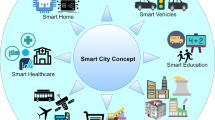Abstract
In order to improve convenience, efficiency, and safety in vehicular networking applications (VNA), we propose a novel business model based on platform production services (PPS), design an inter-cloud architecture, and then apply this emerging scheme to vehicle maintenance services (VMS). Both internet of things (IoT) sensing framework and inter-cloud computing architecture are the crucial factors in implementing PPS business model. In the proposed scheme, implementation concept, system architecture, and scalable applications are introduced. Then we design IoT sensing framework for VNA, including cloud services and computation level scalability, inter-cloud architecture supporting telematics applications, and telematics application scenarios. After dissecting mobile cloud computing forming mechanism, we carry out the semantic modeling analysis for inter-cloud service model, and then design a VMS event processing flow to allow the management and cooperation among diverse components by means of event manager. The performance evaluation exemplified by VMS is implemented by means of probabilistic methods. The results show that convenience and efficiency increase in VNA as compared to existing schemes.















Similar content being viewed by others
References
Almutairi, A., Sarfraz, M., Basalamah, S., Aref, W., & Ghafoor, A. (2012). A distributed access control architecture for cloud computing. IEEE Software, 29, 36–44.
Artemis ju sp3 sofia project. http://sofia-project.eu/. Accessed April 2010.
Atzoria, L., Ierab, A., & Morabitoc, G. (2010). The internet of things: A survey. Computer Networks, 54, 2787–2805.
Chen, M. (2012). Towards smart city: M2M communications with software agent intelligence. Multimedia Tools and Applications. doi:10.1007/s11042-012-1013-4.
Chen, M., Gonzalez, S., Zhang, Y., & Leung, V. (2009). Multi-agent Itinerary planning in wireless sensor networks. In ICST QShine,Spain, November 23–25, 2009.
Chen, M., Leung, V., Mao, S., Kwon, T., & Li, M. (2009). Energy-efficient Itinerary planning for mobile agents in wireless sensor networks. In Proceedings of IEEE International Conference on Communications (ICC’09), Dresden, Germany, June 14–18, 2009.
Chen, M., Wan, J., & Li, F. (2011). Machine-to-machine communications: architectures, standards, and applications. KSII Transactions on Internet and Information Systems, 6, 480–497.
Chen, Z., Xia, F., Huang, T., Bu, F., & Wang, H. (2011). A localization method for the internet of things. Journal of Supercomputing, doi:10.1007/s11227-011-0693-2.
Chin-Feng, L., Yueh-Min, H., & Han-Chieh, C. (2010). DLNA-based multimedia sharing system for OSGI framework with extension to P2P network. IEEE Systems Journal, 4(2), 262–270.
Corcoran, P. M. (2012). Cloud computing and consumer electronics: A perfect match or a hidden storm? IEEE Consumer Electronics Magazine, 1, 14–19.
Edwards, W. K. (1999). Foreword By-Joy, B., Foreword By-Murphy, B. Core Jini. Upper Saddle River, NJ, USA: Prentice Hall.
Filipponi, L., Vitaletti, A., Landi, G., Memeo, V., Laura, G., & Pucci, P. (2010). Smart city: An event driven architecture for monitoring public spaces with heterogeneous sensors. In Proceedings of 2010 Fourth International Conference on Sensor Technologies and Applications, Venice, Italy (pp. 281–286).
Fitch, G. M., Kiefer, R. J., Hankey, J. M., & Kleiner, B. M. (2007). Toward developing an approach for alerting drivers to the direction of a crash threat. Human Factors, 49, 710–720.
Ge, X., Huang, K., Wang, C.-X., Hong, X., & Yang, X. (2011). Capacity analysis of a multi-cell multi-antenna cooperative cellular network with co-channel interference. IEEE Transactions on Wireless Communications, 10, 3298–3309.
Ge, Y., Lamont, L., & Villasenor, L. (2005). Hierarchical OLSR-A scalable proactive routing protocol for heterogeneous Ad Hoc networks. In Proceedings of IEEE WiMob’05, Aug (pp. 17–23).
Gurumurthi, S. (2009). Architecting storage for the cloud computing era. IEEE Micro, 29, 68–71.
Humar, I., Ge, X., Xiang, L., Jo, M., & Chen, M. (2011). Rethinking energy-efficiency models of cellular networks with embodied energy. IEEE Network Magazine, 25, 40–49.
Isaac, J. T., Zeadally, S., & Sierra, J. C. (2010). Implementation and performance evaluation of a payment protocol for vehicular ad hoc networks. Electronic Commerce Research, 10(2), 209–233.
Isaac, J. T., Zeadally, S., & Sierra, J. C. (2012). A lightweight secure mobile payment protocol for vehicular ad-hoc networks (VANETs). Electronic Commerce Research, 12(1), 97–123.
Jiang, W., Xiong, G., Ding, X., Chang, Z., & Sang, N. (2010). Confidentiality-aware message scheduling for security-critical wireless networks. Journal of Systems Engineering and Electronics, 21, 154–160.
Jiang, W., Zhan, J., Chang, Z., & Sang, N. (2011). Energy-efficient and reliable wireless message scheduling for mission-critical cyber physical systems. Control Engineering and Applied Informatics, 13, 95–100.
Karagiannis, G., Altintas, O., Ekici, E., Heijenk, G., Jarupan, B., Lin, K., et al. (2011). Vehicular networking: A survey and tutorial on requirements, architectures, challenges, standards and solutions. IEEE Communications Surveys and Tutorials, 13, 584–616.
Kato, S., Sugawa, S., Tokuda, K., Matsui, T., & Fujii, H. (2002). Vehicle control algorithms for cooperative driving with automated vehicles and inter vehicle communications. IEEE Transactions on Intelligent Transportation Systems, 3, 155–161.
Petrova, K., & Wang, B. (2011). Location-based services deployment and demand: A roadmap model. Electronic Commerce Research, 11(1), 5–29.
Lee, C., Nordstedt, D., & Helal, S. (2003). Enabling smart spaces with OSGi. IEEE Pervasive Computing, 2, 89–94.
Lee, U., et al. (2006). MobEyes: Smart mobs for urban monitoring with vehicular sensor networks. IEEE Wireless Communications, 13, 51–57.
Li, X., Yu, X., Wagh, A., & Qiao, C. (2011). Human factors-aware service scheduling in vehicular cyber-physical systems. In Proceedings of 2011 IEEE INFOCOM, Shanghai, China, April 2011 (pp. 2174–2182).
Li, Z., Chen, C., & Wang, K. (2011). Cloud computing for agent-based urban transportation systems. IEEE Intelligent Transportation Systems, 26, 73–79.
Mahajan, A., Potnis, N., Gopalan, K., & Wang, A. (2006). Urban mobility models for VANETS . In IEEE Workshop on Next Generation Wireless Networks (WoNGeN), Bangalore, India, December 2006.
Michelson, B. M. (2006). Event-driven architecture overview: Event-driven SOA is just part of the EDA story. Technical report. Boston, USA: Patricia Seybold Group.
Olariu, S., & Weigle, M. C. (2009). Vehicular networks: From theory to practice. London: Chapman & Hall/CRC.
Pallis, G. (2010). Cloud computing: The new frontier of internet computing. IEEE Internet Computing, 14, 70–73.
SAE International Surface Vehicle Standard, Draft SAE J2735 dedicated short range communications (DSRC) message set dictionary, unapproved draft rev 24,400 commonwealth driver, Warrendale, PA, May 16, 2008.
Sheth, A., & Ranabahu, A. (2010). Semantic modeling for cloud computing. IEEE Internet Computing, 14, 81–83.
Shi, J., Wan, J., Yan, H., & Suo, H. (2011). A survey of cyber-physical systems. In Proceedings of the International Conference on Wireless Communications and Signal Processing, Nanjing, China, November 2011 (pp. 1–6).
Song, H., Kim, D., Lee, K., & Sung, J. (2005). UPnP-based sensor network management architecture. In Proceedings of International Conference on Mobile Computing and Ubiquitous Networking, Osaka, Japan, 13–15 April.
Suo, H., Wan, J., Huang, L., & Zou, C. (2012). Issues and challenges of wireless sensor networks localization in emerging applications. In Proceedings of 2012 International Conference on Computer Science and Electronic Engineering, Hangzhou, China, March 2012 (pp. 447–451).
Takabi, H., Joshi, J. B. D., & Ahn, G. (2010). Security and privacy challenges in cloud computing environments. IEEE Security & Privacy, 8, 24–31.
Tan, Z. (2012). An efficient identity-based tripartite authenticated key agreement protocol. Electronic Commerce Research., 12(4), 505–518.
Theodora, Z., Vaggelis, S., Angelos, M., & Maro, V. (2012). Modeling users’ acceptance of mobile services. Electronic Commerce Research, 12(2), 225–248.
Wan, J., Yan, H., Suo, H., & Li, F. (2011). Advances in cyber-physical systems research. KSII Transactions on Internet and Information Systems, 5, 1891–1908.
Wan, J., Zhang, D., Sun, Y., Lin, K., Zou, C., & Cai, H. (2014). VCMIA: A novel architecture for integrating vehicular cyber-physical systems and mobile cloud computing. ACM/Springer Mobile Networks and Applications, 19(2), 153–160.
Xia, F., & Ma, J. (2011). Building smart communities with cyber-physical systems. In Proceedings of ACM UBICOMP Symposium on Social and Community Intelligence, Beijing, China (pp. 1–5).
Zhang, D., Wan, J., Liang, X., Guan, X., Liu, Q., & Ji, G. (2012). A taxonomy of agent technologies for ubiquitous computing environments. KSII Transactions on Internet and Information Systems, 6(2), 547–565.
Zhou, L., Wang, X., Tu, W., Mutean, G., & Geller, B. (2010). Distributed scheduling scheme for video streaming over multi-channel multi-radio multi-hop wireless networks. IEEE Journal on Selected Areas in Communications, 28(3), 409–419.
Zou, C., Wan, J., Chen, M., & Li, D. (2012). Simulation modeling of cyber-physical systems exemplified by unmanned vehicles with WSNs navigation. In Proceedings of the 7th International Conference on Embedded and Multimedia Computing Technology and Service, Gwangju, Korea, September 2012 (pp. 269–275).
Acknowledgments
The authors would like to thank the National Natural Science Foundation of China (No. 61262013, 61363011), Guangdong Provincial Strategic Emerging Industries Core Technology Breakthrough Project (2012A010702004), the High-level Talent Project for Universities, Guangdong Province, China (No. 431, YueCaiJiao 2011), the Natural Science Foundation of Guangdong Province, China (No. S2011010001155), and the National 863 Project (No. 2011AA04A104, 2012AA040909).
Author information
Authors and Affiliations
Corresponding author
Rights and permissions
About this article
Cite this article
Wan, J., Zou, C., Zhou, K. et al. IoT sensing framework with inter-cloud computing capability in vehicular networking. Electron Commer Res 14, 389–416 (2014). https://doi.org/10.1007/s10660-014-9147-2
Published:
Issue Date:
DOI: https://doi.org/10.1007/s10660-014-9147-2




